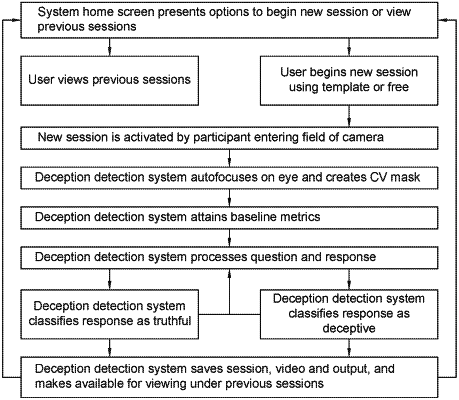| CPC G06Q 10/0635 (2013.01) [A61B 3/0025 (2013.01); A61B 3/0041 (2013.01); A61B 3/0091 (2013.01); A61B 3/112 (2013.01); A61B 3/113 (2013.01); A61B 3/145 (2013.01); A61B 5/1103 (2013.01); A61B 5/161 (2013.01); A61B 5/163 (2017.08); A61B 5/165 (2013.01); A61B 5/4845 (2013.01); A61B 5/4863 (2013.01); A61B 5/6898 (2013.01); A61B 5/7246 (2013.01); G06N 3/045 (2023.01); G06N 3/08 (2013.01); G06Q 10/06398 (2013.01); G06Q 10/10 (2013.01); G06T 7/73 (2017.01); G06V 10/143 (2022.01); G06V 10/454 (2022.01); G06V 10/764 (2022.01); G06V 20/46 (2022.01); G06V 40/18 (2022.01); G06V 40/19 (2022.01); G06V 40/193 (2022.01); G16H 15/00 (2018.01); G16H 30/20 (2018.01); G16H 50/20 (2018.01); G16H 50/50 (2018.01); G16H 50/70 (2018.01); A61B 5/7267 (2013.01); A61B 2503/20 (2013.01); G06N 3/088 (2013.01); G06T 2207/10016 (2013.01); G06T 2207/20081 (2013.01); G06T 2207/20084 (2013.01); G06T 2207/30041 (2013.01); G16H 50/30 (2018.01)] | 15 Claims |

|
1. A method of deception detection based upon ocular information of a subject, the method comprising the steps of:
providing a standoff device configured to view the subject during an examination, the standoff device not in physical contact with the subject, wherein the standoff device has at least one video camera configured to record a close-up view of at least one eye of the subject, and wherein the standoff device has or is connected to a computing device;
providing a cognitive state model configured to determine a high to a low cognitive load experienced by the subject, the cognitive load measuring the extent to which the subject is drawing on mental resources to formulate their response;
providing an emotional state model configured to determine a high to a low state of arousal experienced by the subject, the state of arousal based upon the subject's nervous system activation;
recording, via the at least one video camera, the ocular information of the at least one eye of the subject;
establishing a baseline state of the ocular information of the at least one eye of the subject before questioning of the subject;
asking a question of the subject and allowing the subject to answer the question;
after asking the question and including the time of the subject answering the question, processing the ocular information to identify changes in ocular signals of the subject;
evaluating, via the computing device, the cognitive state model and the emotional state model based solely on the changes in ocular signals and estimating a probability of the subject being either truthful or deceptive;
determining a binary output of either truthfulness or deceptiveness; and
displaying the binary output to an administrator.
|